Blog Category: NodeJS
Everything You Need to Know About Node.js for Backend Development
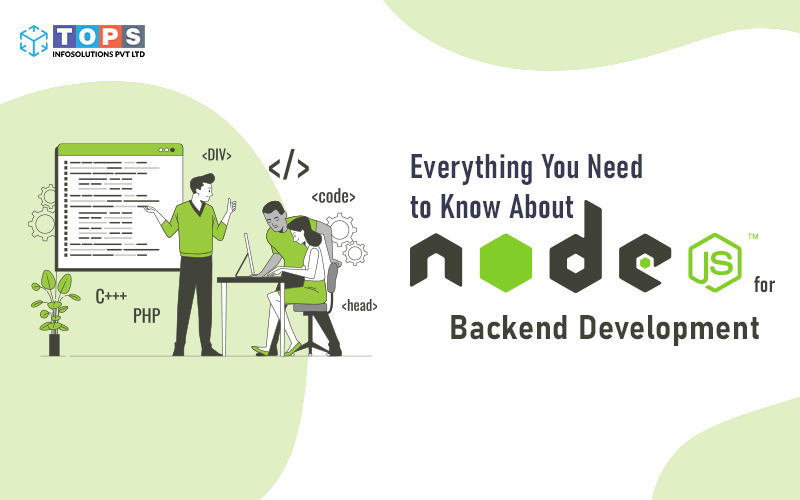
The digital world has grown in leaps and bounds in the past few years. Spurred by the pandemic, the physical world – in an unprecedented manner – made a shift to the digital world.
This, in turn, raised expectations in terms of operational efficiency among businesses. Today, businesses are adopting and adapting to technological advancements to keep up with the changing industrial landscape.
The challenge, however, lies in picking out the best tech stack. This is where the most popular and trusted modern application framework – Node.js – makes its entry.
Node.js development services are extremely popular as this framework is being used by a wide range of businesses such as Netflix, Twitter, etc. for their server-side application development.
StackOverflow’s 2022 Developer Survey shows that Node.js was chosen by 47 percent of its respondents and hence earned its position as the most popular web technology among web developers.
If you are wondering what Node js development services are and how they can add value to your business, read on to learn everything about Node.js!
What is Node.js?
In technical terms, Node.js is described as a single-threaded, open-source, cross-platform runtime environment that facilitates the development of server-side and networking applications that are fast and scalable.
In simpler terms, Node.js offers a balanced intersection of frontend and backend technologies. This means that it extends the capability of JavaScript to run on the server side of both web application architecture as well as serverless architecture.
If an analogy is to be drawn, Node.js is comparable to Java which also runs applications in its runtime. The ease of use and efficacy of Node.js is the reason for the boom in Node js development companies in the USA.
Node.js Frameworks / Approaches
Node.js is on its own an extremely powerful and versatile platform. However, several frameworks and approaches have also been developed to increase the efficiency of Node.js.
Here is a quick snapshot of these frameworks that contribute extensively to Node.js development services:
NestJS
NestJS is built on an abstraction of other Node.js frameworks such as Fastify and Express. This framework is extensible, versatile, and open-source and includes TypeScript, which is a subscript of the popular JavaScript. The abstraction makes this framework easier and faster for developers to learn and work on projects.
Modules, providers, and controllers form the foundation of the NestJS foundation. The first concept – Modules- is nothing but logical units of code put together. All applications need at least one root Module.
However, depending on the code organization, web developers may build more Modules on top of the code. The second component – providers – are abstractions of the code that can be injected at a certain stage as dependencies.
The third and last component – controllers – front end by taking in client requests, executing application logic, and responding.
Due to its ease of use and extensibility, NestJS is quite popular and offers a host of benefits. They are great for developing microservice architecture, lend a strict project structure, and enable a team of programmers to undertake a less bug-ridden development process.
ELECTRON
Electron combines the Node.js runtime with the Chromium rendering engine and facilitates the easy development of desktop applications on JavaScript. Furthermore, it also allows programmers to develop desktop applications in HTML5 and CSS, which are platform-agnostic web languages. Overall, it makes packaging and installation of these applications easier.
Electron is best suited for businesses that require desktop applications. Its framework allows speed up the development process and, therefore, it can be extremely helpful for a business that is looking for quick marketing of its new products.
DENO
The third framework – DENO – addresses the most critical aspect of the application – security, compatibility, and modules. DENO was introduced in 2018 by the creator of Node.js specifically to address the challenges that developers were facing.
The advantage that DENO offers is that the runtime executes in a sandbox safely isolated from the file systems. As a result, attackers are prevented from breaking out and securing access to the server the code is running on.
By allowing modules to be directly imported by a URL, DENO does away with the necessity for a centralized package management system. Also, DENO supports TypeScript which enhances browser compatibility – thus earning its popularity among web developers.
Why Use Node.js?
The popularity that Node.js and the surge in demand for Node.js development services are because of the ease it offers and its applicability in different types of use cases.
Here are a few reasons why you should use Node.js:
Applications are Lightweight and Fast
Node.js is particularly useful when it comes to building small, fast and scalable applications. Collaboration tools and instant messaging apps are the best examples. When coupled with fast synchronization abilities, Node.js can be useful for event-based applications too.
Flexible and Useful in Building Serverless and Microservice Architecture
Node.js is an extremely flexible framework that allows it to be used for the development of serverless and microservice architecture.
Both design styles are extremely popular because they help in saving resources and efficiently manage application lifecycles.
This is nudging more and more businesses across the globe to engage in Node.js development services.
Internet of Things
Node.js is efficient at handling multiple connections and hence works well with IoT. Node.js can successfully handle small messages that are relayed over multiple devices and hence it is very efficient when applied to IoT.
Processing Audio or Video
Another area where Node.js finds much application is processing audio and video. This is because Node.js can much more effectively handle asynchronous input and output. For instance, you can easily and quickly configure a streaming setup using Node.js.
Minimal Ramp Up Times
Because Node.js is built on common web languages, it is very easy to use and hence cuts down on ramp-up time and engineering resources, significantly. Cost efficiency is one of the major reasons for companies to engage in Node js development services.
Integration with C++ Code
As the Node.js runtime is built on a C++ server, it can seamlessly integrate with C++ libraries. As a result, Node.js quickly transmits data between the application code and C++.
How is Node.js Different from Other Backend Technologies?
Each framework is distinct and designed for a specific purpose. While the differences may not be blatantly apparent, they do exist.
Here is a quick comparison of Node.js with Java and Python.
Node.js Vs Java
Node.js and Java are often compared because both run their programs within their own runtime environment. However, there is a clear distinction between the two.
Java has a syntax similar to C++ and is an object-oriented programming language. This makes Java-heavy to use and costly to develop.
Node.js on the other hand is lightweight and based on non-compiled programming languages such as JavaScript.
Node.js is preferred for I/O applications for this reason. Furthermore, its efficiency in handling server-side HTTP requests is another reason that adds to its popularity.
Node.js Vs Python
Python is also widely popular among developers because of its simple syntax and ease of use. However, Python is more comparable to Java in terms of its object-oriented language.
While it is interpreted like JavaScript, its programs are seen to consume a sizeable volume of computing resources.
When Not to Use Node.js?
Node.js is not recommended for application development for fintech. The reason for this is the specifics of work with the floating decimal point that can lead to an accumulation of errors.
Similarly, it is not the best choice when it comes to working with heavily loaded threads that involve a CPU.
Trends in Node.js in 2023 and Beyond
Gauging by the popularity that Node.js enjoys currently, it would be safe to say that it will see much more adoption and integration as the world of business transitions into a more web-driven world.
However, some other Node.js frameworks will also see greater adoption in the coming years.
Frameworks such as Deno are expected to see more adoption due to their modularity and extensibility.
Similarly, Bun, which is a new runtime for JavaScript and TypeScript holds much potential as it offers higher performance and speed.
Amplify, which is a full-stack framework by AWS, and Remix – a newer web technology – is expected to trend in the coming years.
Need expert advice? Reach out to the experts at Tops Infosolutions!
Choose Our Custom Development Services for Your Future Project
If you are looking for hyper-efficient Node.js development services – Tops Infosolutions is the name, you are looking for.
We are pioneers in Node.js development and service clients across the globe. From developing business applications based on MEAN stack to delivering full-stack JavaScript frameworks, Tops offers a range of scalable solutions.
To know more, you can write to us at contact@topsinfosolutions.com or call us at +1 408 400 3737.
All You Need To Know About Node.JS Development

Are you thinking of starting your next project using Node.JS? If yes, then you’re at the right place. Node.JS is a preferred choice when it comes to developing web apps. Some of the leading giants like PayPal, LinkedIn, Uber, Trello, Medium, Microsoft, Zendesk, and Netflix use Node.JS extensively.
What Is Node.JS & How Does It Work?
Being an open source, cross platform runtime environment for JavaScript, Node.JS is widely used for helping JavaScript run on the server. It is considered to be an ideal option for data-intensive real-time applications with.
It is important to note that Node.JS is neither a programming language nor a framework. Node.JS is an environment that was built by Ryan Dahl in 2009. Node.JS development makes the development and maintenance of the web applications easier and quicker. You can meet your business objectives of the project easily.
It is widely used for back-end API services development including:
- Websites
- Single page applications (SPA)
- Chatbot applications
- Data streaming apps
- IoT app development
Benefits of Node.JS
Node.JS is considered to be the right option for building scalable applications. As it provides a cross-platform runtime environment and facilitates load balancing, it is a trusted choice of many developers worldwide. Users who want their modern applications to work up and down according to their requirements should opt for Node.JS development. It enhances the performance of web applications and requires fewer resources.
1. Better Performance
Node.JS enables creating web and mobile applications fast and efficiently. Node.JS can be used to build cutting-edge and high performance apps. As Node.JS supports the non-blocking I/O operations, the implementation and speed of the code execution gets improved.
2. Easy to Learn
JavaScript is one of the most popular programming languages and most of the front-end developers have extensive knowledge about it. JavaScript is a universal language that is used for front-end development. Learning Node.JS is easier and consumes less time. The adaptation rate of Node.JS development is higher, resulting in a positive impact on the overall application development.
3. Extraordinary Tech Stack
Web development teams often look for a robust technology stack. That’s where Node.JS development comes into the picture. A few advantages of Node.JS are:
- High speed and enhanced performance
- Improved productivity
- Better efficiency
- Code sharing and reusability
- Easy knowledge sharing within the team
Along with the above-mentioned advantages, Node.JS also offers great flexibility to the development teams. You can be assured that you will get reliable and secure software with Node.JS.
4. Cost-effectiveness
As you get an opportunity to write the server-side code in JavaScript, there is no need to hire two separate teams for front-end and backend development. Hence, you will be able to save a lot of time and development cost by choosing Node.JS web development. It is the right choice for startups who want to get MVP without digging a hole in their pockets.
5. NPM
Node Package Manager (NPM) is the default package manager for Node.JS. It provides an extensive library, tools, and reusable templates that can be incorporated into the code. Being open source in nature, it offers several software registries to take your development to the next level.
6. Cloud Support
Node.JS works well with cloud computing tools and so, it offers greater flexibility to the developers and users. Business owners can keep the infrastructure costs under control by choosing AWS, GCP, or Azure. It becomes easy to deploy and scale the applications built using JavaScript and Node.JS. It is considered to be the perfect solution for microservices architecture.
7. Large Community
Being open source, it has a large community of developers who stay active and contribute to the betterment of the development. Node.JS has a vibrant and dynamic open-source community that offers great support to programmers and users worldwide. The large Node.JS community works on creating new modules, extensions, and high-level frameworks to improve the platform.
In a Nutshell
It becomes easier for the development team to manage code as now because of NodeJS both frontend and backend can be in Javascript. Node.JS developers do not have to face a lot of roadblocks in managing the codes. The programmers can get feedback from the production to execution. This reduces the application’s time to market.
Node.JS keeps the developers and users happy as it is less complex and highly flexible. As it does not impose any strict guidelines, it is a trusted choice of developers and users across the globe. We are backed up by a team of skilled and talented Node.JS developers who create scalable and secure feature-rich Node.JS solutions for our clients. You get high-performance solutions from TOPS Infosolutions. Being a top Node.JS development company, we work with our clients closely and build innovative real-time web apps as per their business requirements.
Things to Know While Building Web Apps with Node Js to Leverage Its Best

In recent times, many web application development companies prefer Node.js development, and it is far and wide popular with developers everywhere. Node.js is easy to create APIs and build new inter-operational patterns. Let’s throw some light on why the Node.js platform has the best store for web app development.
Node JS Significance
- Node hosts so many advantages over other backend technologies.
- An open-source, cross-platform server environment and scalable architecture
- Executes JavaScript on the server-side and single language usage
- Asynchronous programming and server-side event-driven API
- It runs on various platforms like Windows, UNIX, Linux, Mac OS, and others
- Node js offers free access and is supported extensively by the community of developers
Full-stack development with JavaScript
JavaScript is the simplest way to build apps in the browser, and browser-server communication is seamless. Node js lets you use JavaScript in the backend too. Debugging becomes much more manageable due to JavaScript’s dynamic nature. This technology is straightforward, easy, and offers far better performance than other technologies.
Promoted by Google Chrome
Chrome’s V8 engine provides a runtime environment where the front-end is operated by JavaScript and Node js’ backend. The browser offers the DOM and the rest of the web platform APIs that make it run faster, and Node js removes the bugs in both front and back.
The function of NPM
Node Package Manager, offers various dependable packages to Node. This package management system helps JavaScript developers to share and reuse the code easily among developers.
Asynchronous Server-end Functionality
Both JavaScript and Node js assist well with asynchronous programming. It makes sure that execution is uninterrupted. An error occurred in one block of code does not hinder the performance of other code blocks. Thus the code blocks are independent of each other, and execution happens smoothly. It heightens the speed and overall performance of the program.
Building Real-time Application

Numerous enterprises and tech startups are developing a substantial part of their backend infrastructure using Node js for real-time applications. Before the advent of Node js, the applications were less efficient and expensive due to high resource utilization. Thus, Node js had paved the way for real-time apps ever since.
Server-Side Rendering (SSR)
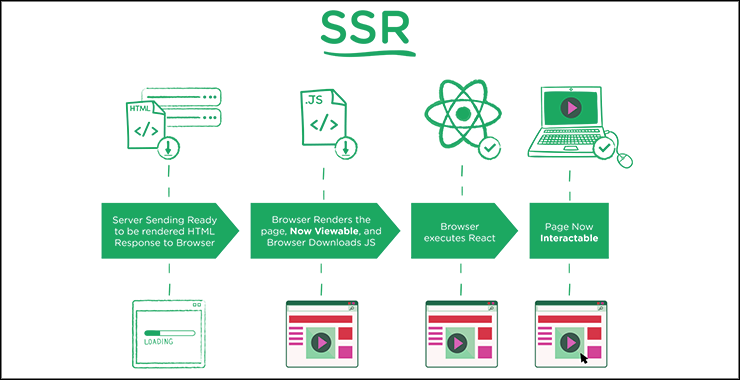
Web apps written in JavaScript are capable of functioning without server-side rendering by a Node server. It is because web browsers can render JavaScript along with HTML and CSS on the client-side. Server-side rendering in JavaScript-based web applications makes it useful for search engine optimization. All central Node js frameworks like Express and Koa assist SSR. When using Node, you expose your JSON documents with a REST API for the front-end to read. A JSON database declares query results that can be parsed easily, straightaway by JavaScript. Therefore the amount of logic for building the application layer is reduced.
Node js is leading the way for being the most preferred framework for service-side web application development. We are a top Node js development company in the USA with proven expertise offering our clients top-notch custom software development services. To schedule a discussion with our experts, then dial +1 408-400-3737
Role of Node Js In Web Application Development By Using Microservices Architecture

Overcoming situations in the development process is, by itself, a challenging task for the developers. Now that several enterprises are opting for microservice architecture, Node js has a prominent role in development. This architecture lets the developers split the application into smaller blocks. These blocks can be developed individually, using various programming technologies, and helps developers to finish the entire task side-by-side in less time. Thus it aids in the agile and agnostic development process.
Node js is a run time environment based on Chrome’s V8 JavaScript engine. It is the go-to technology for startups, enterprises for its speedy development process.
Many leading companies are adopting Node js microservice like GoDaddy, Paypal, Netflix, and many more.
Advantages of Node js microservice
- Non-blocking, event-driven I/O model for top performance real-time web app development
- Allows creating, operating and handling services self-reliantly
- Cuts down much infrastructure so that teams can iterate swiftly
- Abundant modules are accessible for immediate use
- Enhances clarity among developers as they work on separate blocks of web application development. If it nosedives to perform during production, it can be effortlessly secluded and reconfigured
- Offer language and platform freedom for developers
- Efficient resource exploitation and expense optimization
Node js pros and cons are discussed as follows

The Pros:
- Node js supports JavaScript language on both the client and server-side. Thus, hiring separate backend and front-end developers can be avoided and reduce overhead costs.
- Offers top performance as V8 translates JavaScript code into machine code without the need for an interpreter. Also, the run-time environment proliferates the code execution speed tremendously by aiding non-blocking I/O operations.
- Dynamic Community of JavaScript programmers and their contribution is a great advantage.
- Concurrent Request Handling helps execute requests sequentially in a fast manner
- The advantage of caching is that it helps the application load web pages and respond to the user requests quickly, without needing the module code to be executed over again.
- Easy to learn, increases programmer productivity, code reusability, and consumes less time to work with it.
- It facilitates real-time application development like chat apps, games, chatbots, and voice user interface applications like Alexa.
The Cons:
- Unsteady API and the Echma script adds new syntax for writing complex applications, including classes and modules. Thus, programmers have to change the current code base to make it compatible with the Node js API’s latest version.
- It doesn’t have a standard library, and so it becomes hard to achieve regular programming tasks using Node js.
- Not appropriate for heavyweight computing apps As Node js is not supportive of multi-threaded programming yet.
Final Thoughts
Despite the limitations, Node js offers useful features to write several server-side applications, real-time Web APIs, and various networking applications in JavaScript. When it comes to Microservices, it is better first to decide if it suits your requirement from tech experts.
Being the leading Node js development company in the USA, we deliver the scalable solution to get into action soon. You can also hire developers for your project from the best web application development company. Touch base with our experts by calling: +1 408-400-3737
Frequently Asked Question
What is the purpose of Node?
Node lets the developers write code in JavaScript, which runs in a computer process directly instead of in a browser. Node is useful for writing server-side applications with access to the file system, operating system, and everything else necessary for creating fully-functional applications.
What is node js not suitable for?
Node js is not apt for developing heavy computing apps or for performing long-running calculations. It doesn’t support multi-threaded programming as of now. However, it can serve complicated applications more than Ruby. Heavy computations tend to block the inward requests, which results in a decrease in performance.
Is node js better than Java?
If your application involves running loops in millions of calculating tasks, then, in that case, Java will exceed node js. Node is lightweight due to the architecture based on events. It is developed to function as a web server and performs splendidly with servicing lightweight tasks.
Does node js have a future?
Node JS most likely won’t crush. But the chances are that it will match with various options and continue to develop. The future is bright in the front-end world for Node JS as it looks like no front-end development is conceivable without Node. Js, at least for the current time.
Reasons And Benefits To Go With Node.Js for Your Web App Development



The first and foremost challenge in any web application development is choosing the right language. Instead of going with the framework in which the web development company is proficient, it is best to choose the development language based on your requirement. It is crucial because going with the wrong language or an advanced language for a simple requirement can lead to a massive loss of money.
Node.js is a widely-used scripting language, especially for backend development. It offers significant perks such as low time-to-market, dynamic Node.js web applications development, greater agility, and excellent support for highly functional mobile apps development, to mention a few. Node.js is scalable, fast, and very secure.
When to choose Node js?
For simple website development, it needs to display the product varieties, be less secure, and need an economically sufficient programming language for development. But when it comes to complex development requirements, more secure coding should be preferred like Node.js.
Node.js finds its application in the following scenario.
- IoT
Node.js handles multiple concurrent requests and asynchronous processing. E.g., FitBit. - Real-time Chats
Event API functionality and excellent WebSocket support enable the simple implementation of server-side events and push notifications for instant messaging using few code lines. Ex: Whatsapp. - Complicated SPA
Asynchronous data flow promotes flawless data transmission. It uses the same JavaScript language to help in less context switching. Ex: LinkedIn, Netflix. - Real-time Collaboration Tools
Node.js is highly withstanding as it manages multiple I/O operations by several users without server slowdown problems. It’s apt for Trading platforms and social networking sites. - Streaming Applications
Native Stream API helps fractional program download. The rest is stored in the background and can be fetched later when the user requests it. - Microservice Architecture
Enables multi-server linking, simplifying into several short processes, and helps multiple teams to work without bringing many changes to the entire application.
Advantages of Node.js for Web App Development


Node.js offers multiple benefits in terms of expediting the development processing, offering simplified solutions, and many more. Take a look at the following,
Use of single language
Node.js uses one language, JavaScript, on both front-end and backend. Thus the development cycle becomes easy and less time-consuming. Also, fewer resources are sufficient, which decreases much of your overhead cost.
Perform fast operations
Event-driven, non-blocking asynchronous I/O model of Node.js handles a large volume of requests from the web and other networks. An asynchronous task is linked to the event loop, a single-threaded loop, and the call back function. Then the rest of the program is executed. On completion of asynchronous operations, the event loop returns to the task and runs call back. Moreover, Reading/writing to the network connection, file system, and database are executed swiftly.
Node Package Manager Increases code reusability
As Node.js is an open-source technology, it has the code repository and comes with every Node.js installation. It includes more than 350,000 packages for creating effective web solutions. Node.js developers can easily access, update, share, and reuse relevant codes. Working on the core applications has never been easier.
Data Streaming
Node.js possess the capabilities of data streaming, which transfers by breaking a large amount of data into manageable chunks. These data chunks consume less memory and prevent slow- down of the device.
Real-time applications – Node.js is ideal for developing real-time applications like chat apps, games, and chatbots because of event-driven architecture. It accepts large requests and has plug-ins that implement a web-socket protocol. Thus two-way communication channels between client and server become seamless, and the performance of the applications holds well even during a traffic surge.
Final Thoughts
PayPal, Uber, Netflix, Walmart, Trello are some of the Brands that are functioning with Node.js development services. Node.js has increased the standards for web app development, and it has become the go-to technology for both start-ups and enterprises alike. If developing a next-gen enterprise app is what you are looking for, then Node.js is the best shot.
We are a top custom software development company providing Enterprise Software and Mobility Solutions to multiple industry verticals. We provide Node.js development services, and on top of that, we can help you decide the apt technology for your web development requirements. Reach us to consult with a technology expert and to receive free quote in 24 hours.
Why Are The Top Brands Migrating To Node.Js Development?


In recent times, many international brands, like Netflix, Paypal, Trello, and upcoming enterprises, migrate their business applications to Node.js. The main reason for this transition is to create a platform that enables building real-time applications that are quick and scalable. Node.js strengthens the back-end operations, and by using JavaScript, one can develop a complete and scalable server-based application.
Node.js demonstrates robust engagement in IoT (Internet of things), Cloud Stacks, Connected Devices, and a web-based application. Also, in addition to these, it helps to build the business exponentially.
Prime Features of Node.JS
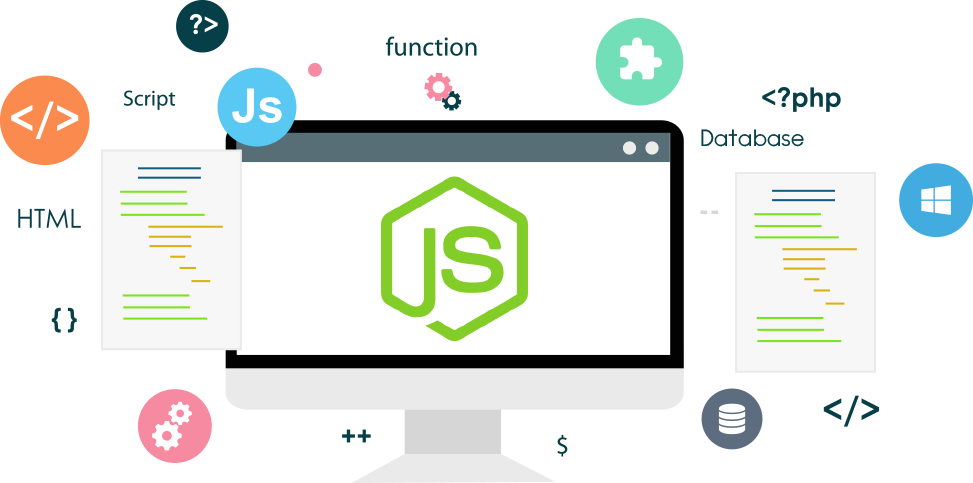

Asynchronous and Event-Driven- All Node.js library APIs are asynchronous. A Node.js based server does not wait for the data to be reverted by an API. The server shifts to the next API once it is called. A notification mechanism of Node.js enables the server to receive a response from the earlier API call.
Very Fast – As it is built on Chrome’s V8 JavaScript Engine belonging to Google, Node.js library executes the code quickly.
No Buffering – thanks to Node.js applications buffering data has been ceased. These applications output chunks of data.
Single-Threaded but Highly Scalable – Node.js is not multi-threaded yet but uses single-threaded along with event looping model. The event looping mechanism unblocks and helps the server to respond quickly. Thus it makes the server highly scalable when contrasted with traditional servers. It can deliver service to a vast number of requests than any customary servers.
Smooth Migration – Node.js has vested JavaScript to extend across the Internet, despite being a browser or a server. Containing it is quite simple, and it enables easy migration.
Node Package Manager – NPM is a tool that manages installations and upgrades of reusable modules. It also handles version updates and dependency management of those modules from the online collection.
Strong Community Support – Node.js has an active community with a trustworthy background. Many notable modules were resultant of this community.
Economic Development Cycle – Node.js involves lesser resources to complete the development cycle tasks. It ensures reduced development expenses for your company. It also helps you to get a better ROI of the web application.
Advantages of Node.js
- Node package manager (NPM) holds access to many open-source libraries
- consumes less tile for development along with end-to-end security
- Reasonable development cycle for a large project with improved features
- Can deal with several client application requests simultaneously
- Swift and flexible front-end and back-end development
- Enhanced productivity and highly secure architecture
- Apt for developing real-time applications
- Full-stack JavaScript with Event-based model
- Accessible technology for micro-services
- Widely preferred for building the Internet of Things
Node.js is an extremely versatile, sustainable, JavaScript-powered technology that enables full-stack developers to gain a distinctive edge during development.
It can be used for I/O related Applications, JSON APIs based Applications, Data Streaming Apps, Single Page Applications, and Data-Intensive Real-time Applications – DIRT. Node.js may not be the best fit for heavy computing applications as it does not support multi-threading yet. But when evaluating the Node.js pros and cons, it has more reasons to be used in development.
What we offer
Our services are rendered globally and are Best-in-class. We also offer customized web app development services as per the requirement. We undertake turnkey projects as well as enhancing existing businesses.
- Node.js consultations, development, and support.
- Expert in creating customized solutions.
- Hands-on experience on Node.js frameworks.
- Skilled in developing applications for various business segments.
- Availability of full stack and specialized engineers.
- Scalable, robust, and secure applications.
- Flexible models to hire Node.js developers
For more information on Node.js development or to hire Node.js Developer, call our experts : +1 408-400-3737
List of best 5 node.js framework packages in 2020
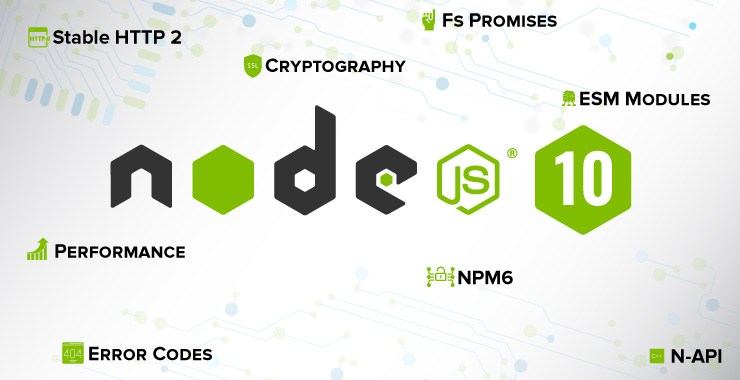

Node.js crossed 10 years last year with a mindblowing 1 million-plus packages available in npm. Downloads are happening at a striking 40% increase every year. Node has joined the openJS foundation, which aims to collaborate with the Javascript community very soon. There are many best node.js frameworks that are downloaded the most. The widely used packages belonging to the node.js family, in no particular order, are as follows.



Express – Expressjs is very much suitable for developing small business models that require high scalability. Whereas choosing a different framework may be suggested for developing more significant projects. If your server poses any performance issues, then Express is the go-to option. Despite being the oldest framework, it has an active community and finds its application in many big companies.
Koa2 – The latest node.js framework developed by the Express.js team based on the MC framework. It is lightweight, better error handling, and proper customization support. Koa2 has removed the issue of creating a sperate code to stream and close a file. It can directly pass a file without the need to stream it.
Hapi – a server framework that can best assist you with building applications and services. Hapi enables developers to write concise application logic. Its main plus points are it is preferred for its robustness, handling high load projects which require it to be scaled. It is most commonly used to build JSON APIs. Hapi posses the below benefits,
- Code Readability — easy source code readability and understanding
- Coverage and Style— use strict convergent rules and hence offers 100% code coverage. Optimized coding style optimized to reduce bugs
- Open Issues— comparatively less open issues or pull requests because of active plugins.
MEAN.io – is a robust open-source full-stack framework for building dynamic websites. It is a full set for building web end-to-end web applications of any size and complexity level. It is the combination of MongoDB, Express.js, Angular.js, and Node.js. Since it is a full package, it is handy. It has excellent community support as it is well-known.
Loopback – is one of the most robust and best Node.js frameworks. It has a default API explorer, which helps to set up a connection with most of the back-end resources. LoopBack is the outcome of the Express.js team, and it also provides support for several databases like MongoDB, Oracle, and SQL.
Due to its powerful features, isomorphic model, and angular SDK resource, big companies and organizations that have preferred Loopback are Symantec, Godaddy, Department of energy – USA, shoppinpal, Cosmunity, and many more.
Some of the most significant aspects are :
- Isomorphic data model definition and design latest end-to-end RESTful APIs that further help developers while setting predefined roles at the user, role, and application levels
- Node Package Manager (NPM) helps the users to create dynamic APIs in their application quickly
- The performance of dynamic server applications are improved by dynamic APIs
availability of 3rd party login, multiple additional components for file management, and storage providers - Runs on-premises or in the cloud
- With this framework, you can use Android, iOS, and Angular SDKs to design new client applications
- Creates REST APIs using the CLI tool, API explorer, and prototypes based on a respective schema
- It can quickly connect devices and browsers to data and services
- Secure and simple-to-use authorization and authentication setup
We are an experienced node.js development company with a diverse project handling expertise team. Reach to us to custom create your website or to further develop existing websites. Dial : +1 408-400-3737
How to Use Node.js Architecture to Build Highly Scalable Apps?



Node.js is ideal for building highly scalable, data intensive, real-time back-end services that power our client applications. You might ask but there are other tools and frameworks out there for building back-end services such ASP.NET, Rails, Django, etc., why choose Node? Before answering the question, let’s understand Node.js architecture.
Node’s “Single Thread” Architecture
Node applications are highly scalable because of the non-blocking or asynchronous nature of Node. What do you mean by asynchronous? As a Node.js developer, let me give you an analogy.
You go to a restaurant. A waiter comes to your table, takes your order, and gives it to the kitchen. Then the waiter moves to serve another table while the chef is preparing your meal. The same waiter can serve many different tables and don’t have to wait for the chef to cook one meal before serving another table.
This is what we call non-blocking or asynchronous architecture and this is how Node applications work. The waiter is like a thread allocated to handle a request. So a single thread is used to handle multiple requests.
In contrast to non-blocking or asynchronous architecture, we have blocking or synchronous architecture. To understand the latter architecture, let’s go back to our restaurant analogy. You go to another restaurant, and in this restaurant, a waiter is allocated to you. The waiter takes your order and gives it to the kitchen. Now he is sitting in the kitchen waiting for the chef to prepare your meal, not doing anything.
One way to look at this analogy is this that the waiter is just waiting. He will not take an order from another table until your meal is ready. This is what we call blocking or synchronous architecture. Now, coming back to your question, that’s how applications built with frameworks like ASP.NET, Rails, and Django work out of the box.
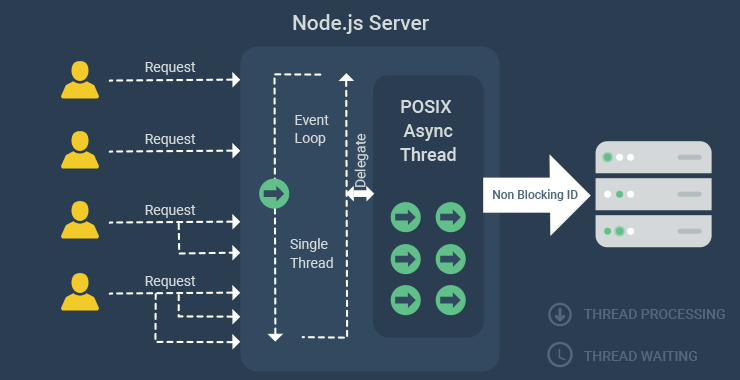

In this architecture, when a server receives a request from the client, the thread is allocated to handle that request. As a part of handling that requests, the thread might query a database, which may take a little while until the result is ready. When the database is executing the query, that thread is sitting there waiting. It can’t be used to serve another client’s request and the server has to allocate it another thread.
If we have a large number of concurrent clients with their requests, at some point we’re going to runout of threads to serve these clients. New clients have to wait until free threads are available. If we don’t want them to wait, we need to add more hardware. That’s why Node.js development companies are in great demand these days.
A real-life example
The real-time chat app to support your helpdesk is based on blocking or synchronous architecture and, consequently, for each new conversation, the app creates a new thread. Let’s say each thread occupies 2MB of RAM and the server has 8GB of RAM installed. The RAM will max out at 4000 concurrent conversations. If you have managed a chat support center, then you know 4000 conversations at a time aren’t surprising. Upgrading server, we all know is a costly affair.
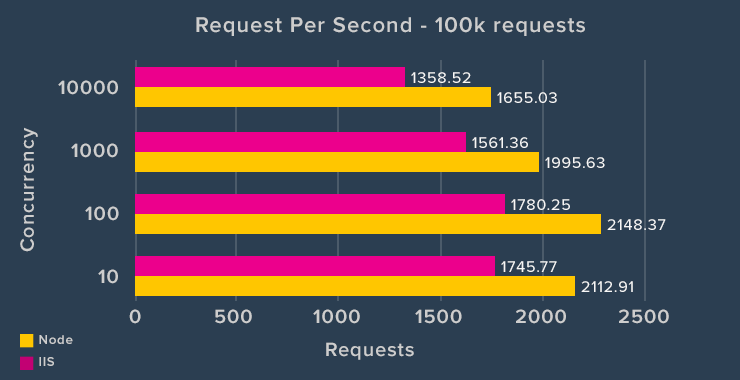

In contrast, a Node.js based real-time chat app can, virtually, achieve scalability levels of over 1M concurrent conversation on a single thread in the same amount of RAM. Of course, even the largest of support centers don’t process this many requests at a time. This is the magnitude of scalability a Node.js application can deliver.
Node’s “Single Thread” Advantage
In blocking or synchronous architecture, we are not utilizing our resources efficiently. That’s why applications built with frameworks like ASP.NET aren’t exactly scalable as they max out at the hardware’s maximum ram.
On the other hand, Node.js Platform uses “Single Threaded Event Loop” architecture to handle multiple concurrent clients. Node.js Processing model is JavaScript Event based model with callback. This is how the model works.
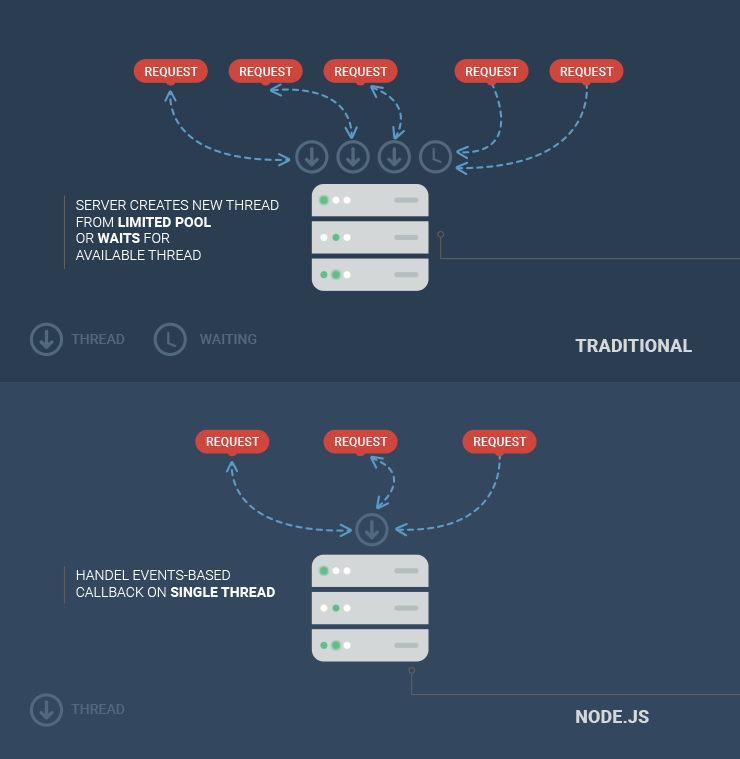

Node web server accepts requests and puts them in event queue. The web server continuously polls for new requests from client in an infinite loop called Event Loop. Event loop is at the heart of Node.js applications and gives them the unparalleled scalability I am talking about.
The event loop operates under single thread in Node. The event loop runs endlessly across the event queue, seeking new client requests. If it finds a new request in the queue, it will flag it as either blocking or non-blocking. The event loop will process the non-blocking request and send the response to user.
Things get a little interesting when the request requires server to perform a blocking I/O operation like accessing the file system or raising a SQL query. In that case, event loop assigns that request a thread and goes about polling for fresh requests in the event queue. The thread, in the meanwhile, processes the thread, performs blocking operations, and sends it back to the event loop with a response. The event loop sends the response back to the client.
An ideal architecture to build scalable apps
Asynchronous architecture makes Node ideal for building applications that include a lot of disk or network access. Your application can serve more clients without the need to throw in more hardware. Thus, Node.js applications are highly scalable.
What are the Best Node js Frameworks?
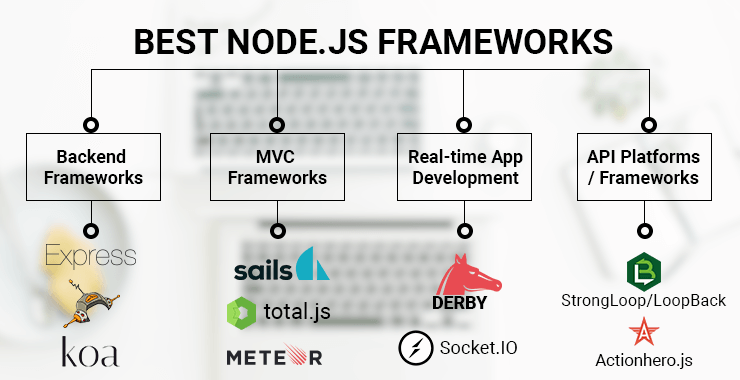

Node js turned the tide across web development when it brought JavaScript under aisle of backend development and made way to fullstack development entirely in JavaScript. JavaScript has been a dominant frontend technology–alongside HTML and CSS–since the days of Netscape. However, its existence as a backend technology was next to none until 2009 when Ryan Dahltook Google Chrome’s V8 engine, which is normally confined to the browser, added an event loop, package manager and a low level I/O API, embedded inside a C++ program and called it Node.
The possibility of writing backend code in JavaScript opened a whole new world to web developers, who could now access the files, listen to network traffic and HTTP requests, access databases directly, etc. all with a line of JavaScript code. This led to many Node js frameworks. You all must have heard of Express but there is more to Node js.
There are tens of Node js frameworks available each overcoming a specific limitation of standalone Node package. Of course, all the frameworks I am going to mention here are available for download on your favorite package manager.
Backend Frameworks
1. Express.js
Express is the most popular Node js framework and a component of MEAN stack. A majority of full stack developers employ the Express framework to setup an HTTP server in Node js with easier to use, feature-rich Express APIs. Express APIs, essentially, add a set of additional features to already robust Node js API architecture without overriding it.
However, Node js has its own share of limitations. The most profound of them is Express requires a little more manual actions than most JavaScript developers are accustomed to. Alienated developers may also dislike the larger footprint of web applications developed in Express.
This may make you ask the question,“why is it still so popular?” The obvious answer is Express has its own little ecosystem of itself. That is a Node js developer can easily extend Express, which is itself an extension to Node, with an Express Framework framework like Kraken.js. Kraken.js isn’t the only one.
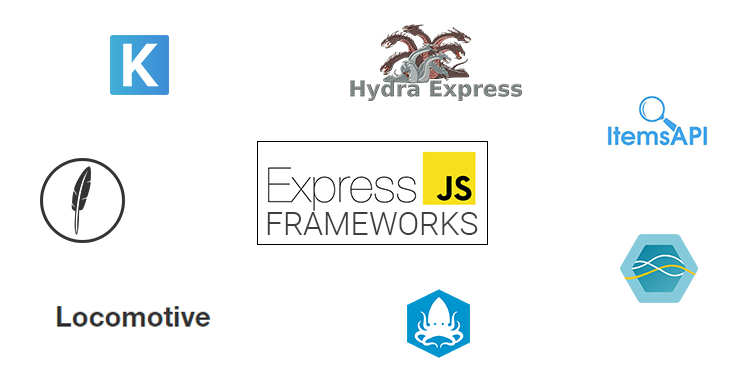

This level of extensibility has garnered Express.js support of major startups into mobile space: MySpace, PayPal, and Klout, which, gradually, led to wider developers’ and makers’ adoption and attention respectively.
2. Hapi.js
What happens when one of the Fortune-500 companies turns up against the likes of Amazon and eBay on Black Friday to compete in online sale finds Express.js a little short of their expectations? It commissions Hapi.js, a Node framework that builds on the shortcomings of Express and shares the same codebase.
Express is a lightweight framework perfect for building your next single-page application on. If you expect your server application to scale at the enterprise level, then this isn’t the framework I would recommend. I am not commenting about the final application’s performance as it would behave as would any other JavaScript application.
Hapi addresses the biggest shortcoming Express.js has that makes Express unsuitable for developing enterprise applications—the inability to split code into small chunks. Enterprise applications can go thousands of lines of code and are, generally, coded by distributed engineering teams. The inability to split codes into small chunks bounds achievable code distribution amongst teams or, in terms of enterprise developers, limits extensibility and maintainability.
Hapi.js is extendable with a rich set of plugins for adding enterprise functions to a Node application, including authorization, authentication, metrics, and logging. Hapi developers tend to focus more on writing reusable application logic than spending time building infrastructure. OpenTable, Macy’s, Condé Nast, and Disney are users of Hapi.js.
3. Koa.js
Koa.js is once again a Node js framework to build applications and APIs on. Koa is the brainchild of initial contributors to the Express.js project on GitHub. It works more or less like Express, except it uses generators to manage callbacks and is more tolerant to errors.
Developers developing applications that will generate too many callbacks can save many complications by choosing Koa over Express.js.
MVC Frameworks
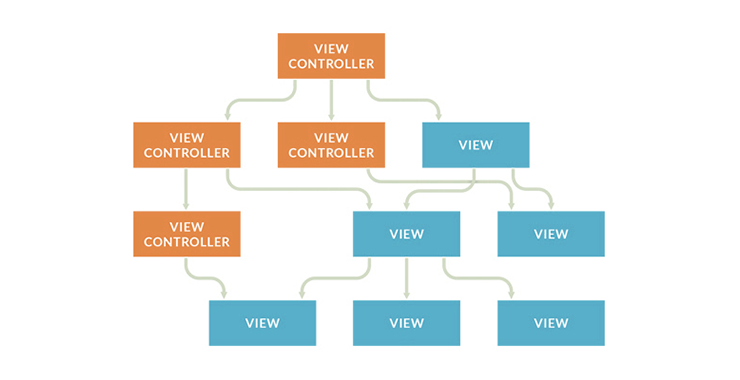

4. Total.js
All the above Node js frameworks are great for building server applications but not creating complete web apps with frontend and backend. For building a web application, developers ask for MVC frameworks like Ruby on Rails or Laravel. Total.js is a sort of MVC framework that is built upon Node js like others in the list but provides approachable endpoints to integrate database and frontend technology of your choice.
The Node part of Total.js, in addition to a full web server, includes SMTP mail client, image processing algorithms and web socket among a few. At the time of writing, Total.js was compatible with Angular, Backbone, React, Ember, and of course, Bootstrap when it comes to front-end frameworks and MongoDB, CouchDB, PostgreSQL, SQLite and MySQL when it comes to databases.
5. Sails.js
Sails.js is Ruby on Rails equivalent on JavaScript, particularly when handling HTTP requests. I mean it is a MVC micro-framework for building full-stack enterprise applications very much like Total.js. Sails.js is compatible with most frontend JS frameworks Total.js is.
The two chief ingredients of Sails.js are Express.js and Socket.IO. The ability to generate RESTful JSON models with support for WebSockets and HTTP makes Sails.js a perfect framework to write data-oriented and real-time applications like chat portals.
6. Meteor.js
Full-stack JavaScript applications developed in Meteor contain client-side and client-side rendered JavaScript, the pertaining logic, and markup files. Meteor.js has fewer commonalities than Node js frameworks mentioned above. Unlike Express, it’s highly opinionated and strictly follows MVC framework architecture, which may annoy developers coming from lightweight frameworks like Express and Koa.
Meteor.js even has default elements for every component in its web development stack. Of course, they are interchangeable but this makes the framework less flexible.
Real-time Application Development
7. DerbyJS
Derby is a special purpose Node framework for developing web applications to enable real-time collaboration. To enable collaboration between its users, DerbyJS has a dedicated data synchronization engine, Racer. Racer syncs data between users and makes real-time collaboration a possibility.
Also, DerbyJS is an MVC framework. That is, the view is updated every time the model changes. Also, DerbyJS applications are search engine friendly.
8. Socket.IO
Socket.IO enables real-time communication in chat apps. It opens an event-driven, duplex communication between client and server. A WebSocket-compatible server,Socket.IO provides real-time collaborative features and analytics.
Socket.IO is platform agnostic and goes with almost every device, OS, or browser. One of its tops clients is Flightcar. FlightGear, as the name suggests, rents cars from the airport while traveling.
API Platforms/ Frameworks
9. StrongLoop/LoopBack
LoopBack, along with the StrongLoop API platform, is a vastly extensible Node js API framework developed by IBM. LoopBack APIs connect devices and integrate Android and AngularJS SDKs for mobile app development.
When it comes to supporting for databases, LoopBack supports all major database systems: Oracle, Mongo, and SQL. StrongLoop is a special version of Node js and a stress-free API tool for Express professionals.
10. ActionHero.js
This fast, lightweight Node js server builds reusable, scalable API servers that are inter-compatible and are backward compatible. By using the same API code for HTTP and socket transports, it gives access to APIs and any static data on the server to an authorized client.
TaskRabbit and Samsung are two key Actionhero.js users.
Final Thoughts
The Node js ecosystem is vast and will only grow in the future. Most of the Node js frameworks described above are quite mature and backed by a large community. Node, or JavaScript, as a back-end technology makes for fantastic real-time applications for collaboration, chatting, etc.
Since most of the mentioned Node js frameworks are either based on Express or built by the same team, they share a lot of common features and, thus, give an easy switch to developers moving from one to another. A developer moving from Express to StrongLoop for developing an API server will only take a couple of hours to make the switch.
While I am not a big fan of opinionated Node js frameworks and would prefer lightweight Express with little additions, these MVC frameworks lets you build fantastic applications without paying too attention to setup and thus saving you a lot of precious time.
best node.js fr
Frequently Asked Questions
What are the best Node js frameworks used for development?
Express, koa, Meteor, Sails, Derby, Socket IO, Actionhero.js are some of the best and popularly used Node js Frameworks.
Why does Node js have so many frameworks?
Writing backend code in JavaScript is possible, and this opened a lot of opportunities for web developers. They could now access the files, access databases directly, listen to network traffic and HTTP requests, and do more with a single line of JavaScript code.
Why is the Express framework still popular?
It is because Express has its ecosystem that lets a Node js developer easily extend Express, which is an extension to Node.
When can Node js be used?
Node js can be used as a backend technology for real-time applications, especially those involving collaboration, chatting, etc.
Node.js 10.0 Fills Some Gaps, Polishes A Few Rough Edges


Node.js 10 was released this April and I just wanted to kind of touch on what’s new—the additions improvements, etc. Obviously, I’m not going go through the extensive change log or anything but I just want to mention the major things. The changes are so many that you’ll find this information in series of articles elsewhere but I figured that I would wrap it up in one article and try to convey it in a simple way.
I know these aren’t the most exciting articles to read and share in the world but if you’re a JavaScript developer or someone who works of a technology firm, I think it’s really important to keep up to date with these things. It’ll be a short article.
-
Standardized Error Codes
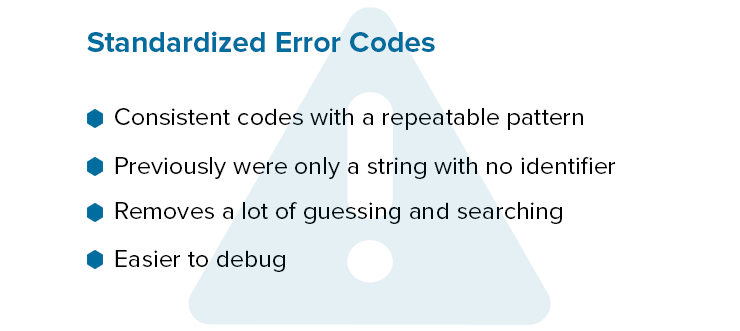

If you’ve worked with errors and debugging node it can be kind of a pain. Before we got some weird string based error messages that we’d have to constantly look up or sometimes guess what they mean, but now with Node.js 10 they adopted standardized error codes. We have consistent codes with a repeatable pattern instead of a string with no identifiers.
This will make debugging and error handling easier and it will remove a lot of the guessing and the searching—looking up things on Google and Stack Overflow. Applications are easier to debug and offer faster development.




With Node.js 10, we can actually check for error codes. We’ll get a specific error code that we can handle. Node.js 10 is will make debugging easier.
-
Stable HTTP/2
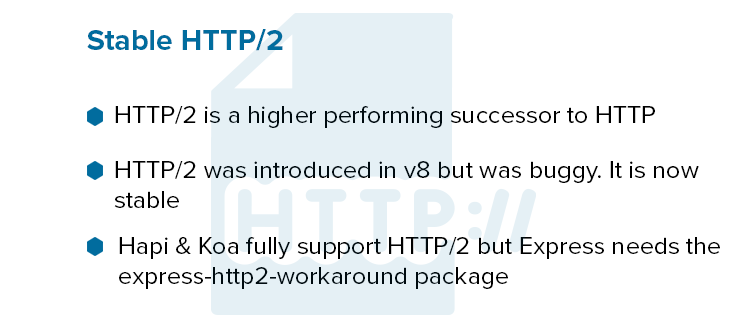

HTTP/2 is a higher performing successor to HTTP. If you really haven’t looked into HTTP/2, it’s not a rewrite of the protocol or anything like that. All the HTTP methods, the status codes, the semantics are the same. You should be able to use the APIs as with HTTP/1. X. There will be some additions but everything should be backward compatible.
HTTP/2 was introduced in Node 8 but it was known to be very buggy. In version10, it’s now completely stable and safety use. As far as frameworks go HapiJS framework and KOA framework fully support HTTP/2 right out of the box. As far as Express is concerned, you need to use the Express-HTTP/2-workaround package. The focus of HTTP/2 is performance specifically end-user perceived latency and network and server resource usage.
Having stable HTTP/2 is a pretty nice addition to Node.js 10.
Let’s take a look how the code would look like with Hapi JS and HTTP/2.


As you can see,we’re basically creating a connection or setting our routes and handlers. The syntax is not much different. We’re just using the HTTP/2 module.
-
Better Support for ESM Modules
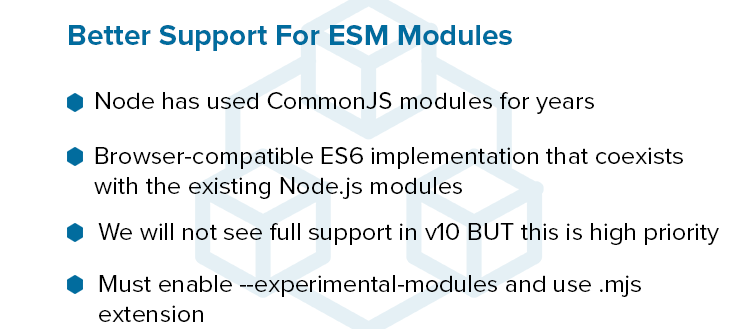

Node.js 10 does offer better support for ESM or ECMA Script modules. For years, Node has used CommonJS modules.
If you don’t know what that is, it’s when we bring in our packages using const, equalrequire, express or whatever module. ECMAScript modules or ES6 modules is where we say import something from something for example React, Angular, and most front-end frameworks use syntax with Webpack and Babel.
Understand that pure native ECMA Scriptmodules are not standardized yet. They’re not ready to be used by default in Node.js 10. They are getting closer and it’s a huge priority. It’s difficult for them to integrate along with the CommonJS modules.
For now, we can enable the experimental-modules flag and any file where you want to use ESM or ECMA Script modules. You just have to give it .mjs extension. I’ll be happy when we can just use ES6modules right out of the box.
You can implement Babel on your server side and use them. It would be nice to not have to do that any more and just have it right out of the box.
I came across a Medium article that tells why it’s so hard for them to get native ESM into Node.
The support for ESM modules is getting better we can use the experimental modules flag–just use the MJS extension. I wouldn’t really suggest doing this in production but you know you can mess around with it and they’re getting closer.
- N-API
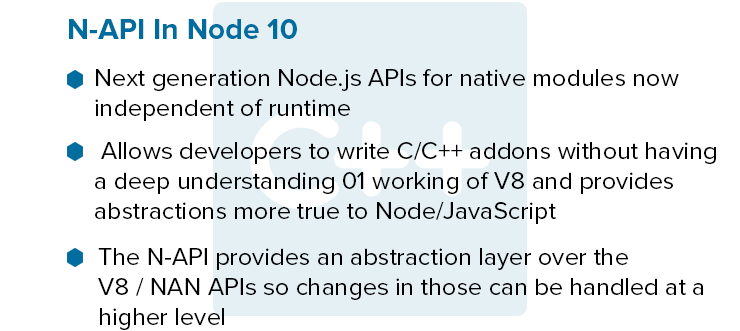

N-API is the next generation of node.js APIs for native modules introduces with Node.js 10. it’s now completely independent from the JavaScript runtime–V8. Before it was tightly coupled with the runtime. Now it’s actually maintained as a part of node.js.
This opens up doors for engines like Microsoft Chakra, which is a JavaScript engine that powers Microsoft Edge browser. Developers can write C and C++ add-ons without having a real deep understanding of the V8 engine itself because now it provides better abstractions that are more true to Node in JavaScript. Apparently, Node 10 will make it not only easier but also more stable.
Every time there was a Node update, developers would have to completely revise a lot of code due to its binding to V8. There’s higher level of abstractions that can make this much easier for them.
-
Modern Cryptography


With Node.js 10, Open SSL has been updated to version 1. 1. With TLS 1. 3, we’ll have faster SSL handshakes and even better security. Node.js 10 includes ChaCha20 cipher, which is a high speed cipher. It is up to three times faster than AES, which is the current industry standard. There is also poly1305 Authenticator for authenticated encryption, which is going tomake Node more secure overall.
-
fs/Promises
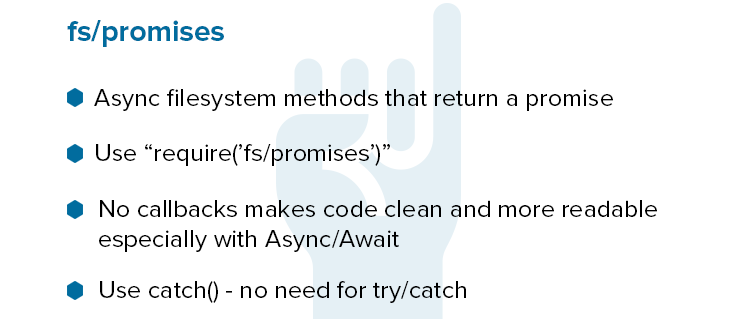

If you’ve worked with node you’ve probably worked with the FS or the file system module which allows you to interact with the file system. In Node 10, we have the experimental fs.promises, which mean we can now use asynchronous file system methods that return a promise. We can use this require fs.promises. We’ll get methods, where we don’t need to use callbacks and it will make our code cleaner and readable if you use a sync await.
With fs.promises in Node 10, for error handling we don’t need to use try-catch blocks because where it’s promise based we can now use .catch.
Let’s look at an example.


In the above code, we have the regular fs or filesystem module and then the Promisesbased one. We’re just reading a file synchronously and we have doTruncate method that is using fs.Promises module along with asyncawait to truncate this.
The code is truncating it to four characters and then we’re just logging it out.
It started off as node.js. Now it’s going to just read Node.
fsPromises method makes it much more elegant to do this rather than using like callbacks where we’re using async await.
As in the last line of the code example, we can use .catch. if we have any errors, we can log those errors.
-
Performance Improvements
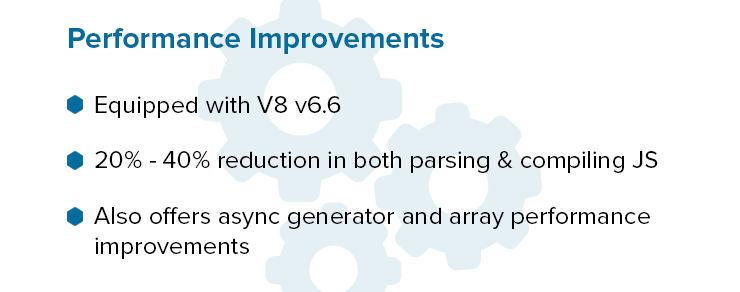

We should see quite a bit of improvement because Node is powered by the V8 JavaScript engine, which is the same engine that Google Chrome uses. With version 6. 6 of V8 which is included with Node 10, we should get a pretty nice performance bump.
Chrome 66uses the latest version as well and there’s been a twenty to forty percent reduction in parsing and compiling JavaScript. We should see some nice improvements. It also offers async generator and array performance improvements.
Node.js is getting faster.
-
NPM 6
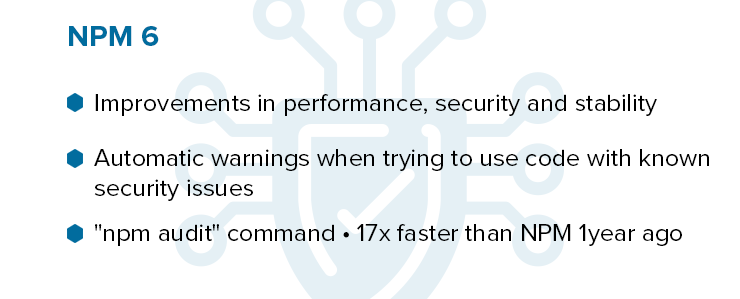

Node.js 10 is shipped with NPM 6 which comes with its own set of improvements including performance, security and stability. I did underline security because that seems to be like the main theme of NPM 6. NPM recently acquired lift security and the Node security platform which identifies vulnerabilities for developers and security vendors.
With Node and NPM 6, you should start to get automatic warnings when trying to use code and packages with known security issues. We have the new audit command npm audit. The command will look at your applications dependency trees, identify if anything is insecure, tell you about it, and then if you wanted to, you could switch it out for an alternate, safer dependency.
NPM is now 17 times than it was exactly one year ago, which is pretty impressive progress.



